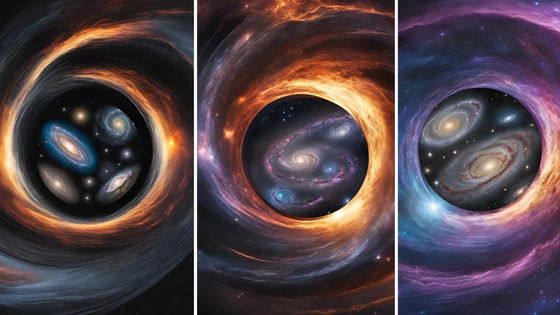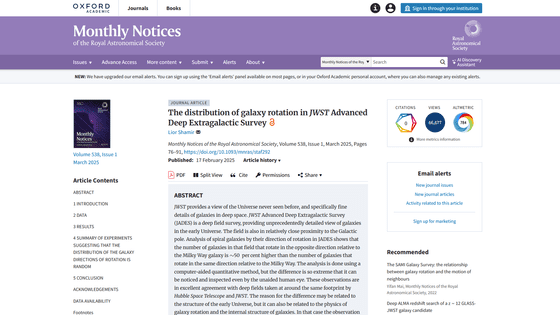James Webb Space Telescope discovers galaxies are misaligned in their rotation, strengthening the theory that the universe is inside a larger black hole

The
distribution of galaxy rotation in JWST Advanced Deep Extragalactic Survey | Monthly Notices of the Royal Astronomical Society | Oxford Academic
https://academic.oup.com/mnras/article/538/1/76/8019798

Study finds Milky Way rotational velocity should be factored in deep space observation
Is our universe trapped inside a black hole? This James Webb Space Telescope discovery might blow your mind | Space
https://www.space.com/space-exploration/james-webb-space-telescope/is-our-universe-trapped-inside-a-black-hole-this-james-webb-space-telescope-discovery-might-blow-your-mind
Just as the Earth, Moon, and Sun rotate, galaxies also rotate, and there are two directions: clockwise and counterclockwise. If the universe were completely random, the proportion of galaxies rotating clockwise and counterclockwise would be 50% each. However, observations by the James Webb Space Telescope have revealed that of the 263 galaxies studied, two-thirds rotate clockwise and one-third rotate counterclockwise.

'We don't know the exact reason why the rotational bias occurs, but one possibility is that the universe was born in a rotating state,' said Leon Shamir, an associate professor at the Carl R. Ice Institute of Technology. 'This is consistent with the Schwarzschild cosmology, which postulates that the entire universe is inside a black hole.'
Schwarzschild cosmology is the theory that the human observable universe is the interior of a black hole floating in a larger universe. Black holes have a boundary called the '
What is the 'Schwarzschild cosmology' that claims that the entire universe is inside a black hole? - GIGAZINE

A black hole is a celestial object that is born when a massive star collapses, and at its center there is matter with a density far exceeding that of anything in the known universe. The matter drawn into the black hole falls into a place called a ' singularity ' where gravity is infinite, but according to the theory of Nikodem Poplawski, a theoretical physicist at the University of New Haven, as it falls into the singularity, the twisting and rotation of the matter and the bonds between the matter become very strong, and once it passes a certain point, the matter stops collapsing and rebounds like a compressed spring, and begins to expand rapidly. In addition, in the process of rapid expansion, countless particles are generated, and the mass inside the black hole increases exponentially.
Poplawski proposes that the recoil from these black hole events led to the phenomenon known as the Big Bang .
Therefore, Poplawski explained the bias in the rotation direction of galaxies as follows: 'It is possible that the direction of rotation of the black hole that contains our universe influences the direction of rotation of the galaxy. On the other hand, the remaining third of galaxies that rotate counterclockwise are responsible for avoiding the singularity of the black hole and creating a new universe.'

'The James Webb Space Telescope's discovery that galaxies are biased in their rotation supports the theory that black holes create new universes, and we hope that these theories will one day be confirmed,' Poplawski said.
On the other hand, Shamir's research team also pointed out the possibility that the bias in the galaxy's rotation direction may be due to the rotation of the Milky Way itself. In conventional cosmology, it was thought that the rotation speed of the Milky Way is very slow and would not affect observations by the James Webb Space Telescope. Shamir said, 'If it is confirmed that the results of this observation are due to the rotation speed of the Milky Way, we will need to recalibrate distance measurements in deep space. Recalibrating distance measurements may help solve various problems in cosmology, such as differences in the expansion rate of the universe and the existence of stars that are older than the universe .'
Related Posts:
in Science, Posted by log1r_ut







